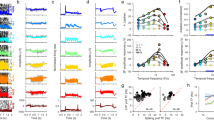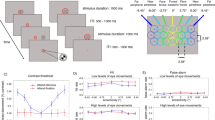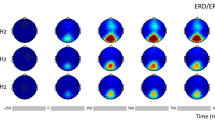Abstract
THE average evoked electroencephalogram potentials (EP) in humans are reduced in amplitude if the flashing target is structured instead of uniformly illuminated1. Furthermore, if the flashing stimulus is presented to one eye, the EP is decreased when the other eye sees a steadily illuminated target instead of a dark field2,3, or when the image moves instead of remaining stationary on the retina2. These effects were attributed to the increased complexity of the presentation, which absorbs more cortical capacity and leaves less to participate in the evoked response. The question arises whether the EP elicited by monocular flash stimulation is sensitive enough to reveal changes related to the target structure presented to the other eye.
This is a preview of subscription content, access via your institution
Access options
Subscribe to this journal
Receive 51 print issues and online access
$199.00 per year
only $3.90 per issue
Buy this article
- Purchase on Springer Link
- Instant access to full article PDF
Prices may be subject to local taxes which are calculated during checkout
Similar content being viewed by others
References
van Hof, M. W., van Hof-van Duin, J., van der Mark, F., and Rietveld, W. T., Acta Physiol. Pharmacol. Neerl., 11, 485 (1962).
Lehmann, D., Beeler, G. W., and Fender, D. H., Electroencephal. Clin. Neurophysiol., 22, 136 (1967).
Riggs, L. A., and Whittle, P., Vision Res. (in the press).
Kaufman, L., Pitblado, C., and Miller, J. F., Ann. Meeting Psychonomic Soc., Chicago (1965).
Author information
Authors and Affiliations
Rights and permissions
About this article
Cite this article
LEHMANN, D., FENDER, D. Monocularly Evoked Electroencephalogram Potentials : Influence of Target Structure presented to the other Eye. Nature 215, 204–205 (1967). https://doi.org/10.1038/215204a0
Received:
Revised:
Issue Date:
DOI: https://doi.org/10.1038/215204a0
This article is cited by
Comments
By submitting a comment you agree to abide by our Terms and Community Guidelines. If you find something abusive or that does not comply with our terms or guidelines please flag it as inappropriate.



